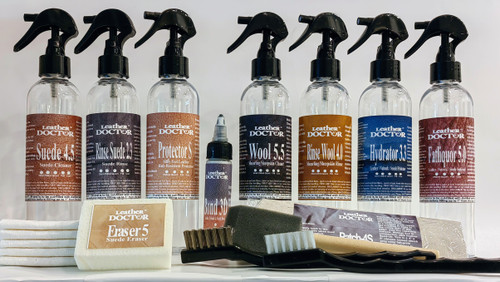Shearling Suede Repair and Care Kit SS7 by Leather Doctor is to clean, condition, protect, and repair both the wool and suede face of sheepskin garments.
People Also Ask:
- What is Shearling Suede?
- Why Suede Rips and Tears Easily?
- When to begin a Repair?
- Why are products in Concentrate?
- How to Clean and Condition the Wool?
- How to Clean, Rinse, Hydrate, Fatliquor, and Exfoliate the Suede?
- How to Repair Suede Rips and Tears?
- How to Repair a Suede Hole?
- How to Repair a Weaken Rip Seam?
1: What is Shearling Suede?
- Shearling Suede is a double face clothing made from a sheep or lamb that is suede as the outer face and soft-sheared wool as the inner face.
2: Why Suede Rips and Tears Easily?
- Suede rips and tears easily when the original fat liquor (fat and oil) diminishes through aging as the fat and oil content evaporates away.
- Cleaning with high alcohol content or washing products and water will also cause the fat and oil content to leach away.
- A clear sign of the suede weakness is the appearance of creases and wrinkles that quickly develop on the sleeves, and the garment looks tired.
- When stress on dried suede it will rip and tear easily.
3: When to begin a Repair?
- Suede rips and tears repair begins after cleaning, conditioning, and exfoliating to reveal a cleaner and stronger surface.
4: Why are Products in Concentrate?
- Concentrate product has an indefinite shelf life.
- Does not freeze.
- Has less handling damage.
- Save on shipping weight.
- It must be mixed with distilled water accordingly before use or 1 inch from the top of the 8oz bottle.
5: How to Clean, Rinse, and Condition the Wool?
- Complete cleaning of the entire shearling begins from the wool side and when it finally dries continues with the Suede.
- Wool Dry Soil Removal begins by brushing with a stiff brush at an angle in one direction and vacuum.
- Cleaning is performed with Sheepskin Wool Cleaner 5.5, sprayed and brushed with the stiff brush at an angle in one direction, and suspended soiling is extracted by towel changing folding sides until the towel shows clean and dry, then continue with Rinse 4.0.
- Rinsing is performed with Sheepskin Wool Rinse 4.0, repeated in the same manner as Cleaner 5.5, is left for a complete dry and brushed for a bloom, and is ready for Protector S.
- Conditioning is performed with Leather Protector S, sprayed and brushed for an even appearance, leaving it to dry and brushed again when dry to bloom and ready for use.
6: How to Clean, Rinse, Hydrate, Fatliquor, and Exfoliate the Suede?
- Dry Soil Removal first by brushing, erasing all surface soiling with a matching suede brush and suede Eraser 5, followed by vacuuming.
- Cleaning is performed with Suede Cleaner 4.5, sprayed, brushed, erased, and towel extracted until new folding shows clean.
- Rinsing is performed with Rinse Suede 2.3, sprayed, brushed, and erased with towel extraction until the new folding side is clean and dry, and is ready for hydration.
- Hydration is performed with Hydrator 3.3, sprayed and brushed into the suede structure to plump with moisture oozing out when gently pressed between thumb and fingers.
- When the suede is fully relaxed, stretching and massage manipulation further softens it to satisfaction.
- The excess moisture content is towel extracted until folding changing the new side to show clean and dry, it is then ready for fatliquoring.
- Fatliquoring to replenish fat and oil is performed with Fatliquor 5.0, sprayed over the damp suede, and works to plump the suede again with saturation and is left to dry naturally.
- Fatliquor 5.0 on each application is repeated to be left naturally dry until the last application is fully saturated.
- With the last application almost dry staking, massaging, and flexing the suede to fully dry produce softer suede.
- Exfoliating is performed with Suede Eraser 5, to remove dry rotting, old, and worn suede to refresh a new nappy appearance with a soft finger-writing effect. It is now ready for repair.
7: How to Repair Suede Rips and Tears?
- Suede rips and tears repairs are done with Glue 3D, a new adhesive bond that dries translucent through the repairs, smooth and strong, and the techniques deployed as follows:
- Product and Tools: Leather Glue or Bond 3D and a choice of tool used to apply the glue should be smaller than the size of the split for better control, such as the tip of a teaspoon, bamboo skewers flattened at the tip, or ice-cream stick reduced in size to fit. Cotton bud for removing the excess.
- Split Fit Test: A split fit test ensures no missing bits when the edges are pulled or pushed closed to fit, otherwise donor bits have to be made ready in place.
- Split Glue Application: Glue 3D is transferred to the tip of the tool of choice and spread thinly onto the open-split, any excess is removed with a cotton bud.
- Split Close-Up: Closing up of the split and alignment adjustment is done with a clean tool with good contact and also lastly to smooth out the edges before leaving to dry.
8: How to Repair a Suede Hole?
- Repairing a hole with missing fibers will need some fiber-filling extension taken from hidden areas as a donor for filling in conjunction with Glue 3D. Repairs are similar to a rip and tear repair.
9: How to Repair a Weaken Rip Seam?
- A weakened seam structural repair that carries weight will require greater strength by a combination of increasing hydrating and fatliquoring to regain tensile strength before repair.
- A leather Patch 4S is used as a sub-patch for extra strength in the repair. Extra strength is gained by the Patch 4S when going through with hydrating and fatliquoring before using it.
- The Patch 4S is used from the wool side and has to be shaven half an inch from the edge to allow the Patch 4S direct contact for both stitching and bonding.
- Camouflage when necessary for appearance is done by adding a new Bond 3D application and having donor suede fibers partially pressed into the second layer of Bond 3D. Practice this procedure on a scrape to understand how it works before the actual repair.
All questions and comments are welcome to improve this Product Overview and Instruction.
Edited on April 6, 2024, by Roger Koh.











